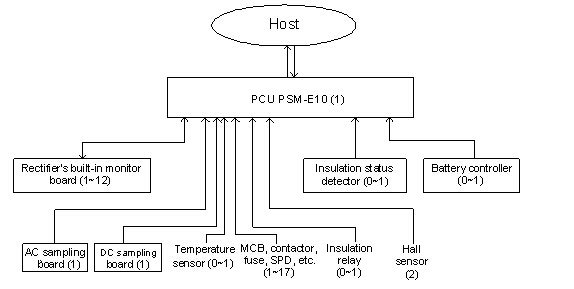DC Power
Emerson PSM-E10 (PSM-E10) Monitoring System
System Architecture of Emerson PSM-E11
The PSM-E11 monitoring system architecture is shown in the following figure. The numbers in the brackets are the numbers of the corresponding parts that can be connected to the system.

PCU PSM-E11 has built-in distribution monitoring-box, which directly collects signals from the AC/DC power distribution. As shown in the figure, the core part of the monitoring system is PSM-E11 PCU, which collects information from downstream monitors, and, after analysis and calculation, displays the information, raises alarms or sends control commands to the downstream monitors. Through communication protocol Modbus, CDT91, DNP3.0, IEC101, or IEC103, the PCU can also send the information to the host, and receive control orders from which, in order to realize the unattended operation of the power system.
|
Alarm display
|
Alarm description
|
Max. number
|
|
Output branch off
|
Output branch trip
|
1536
|
|
batt fuse fault
|
Battery fuse broken
|
2
|
|
SPD fault
|
|
1
|
|
Bus insu fault
|
Bus insulation deteriorated
|
2
|
|
Output branch insu fault
|
Output branch insulation deteriorated
|
384
|
|
AC/AC fault
|
|
1
|
|
DC/AC fault
|
|
1
|
|
DC/DC fault
|
|
1
|
|
SW module offline
|
Communication between output branch status detector and PCU interrupted
|
64
|
|
BMS offline
|
Communication between BMS and PCU interrupted
|
12
|
|
Batt Ct low
|
Battery capacity low
|
2
|
|
AC panel offline
|
AC panel communication interrupted
|
1
|
|
PB high volt
|
Switching bus high voltage
|
2
|
|
PB low volt
|
Switching bus low voltage
|
2
|
|
CB high volt
|
Control bus high voltage
|
2
|
|
CB low volt
|
Control bus low voltage
|
2
|
|
AC high volt
|
AC over-voltage
|
6
|
|
AC low volt
|
AC low voltage
|
6
|
|
AC off
|
AC power failure
|
2
|
|
AC phase lack
|
AC phase failure
|
6
|
|
batt high curr
|
Battery high current
|
2
|
|
cell high V
|
Battery cell high voltage
|
216
|
|
cell low V
|
Battery cell low voltage
|
216
|
|
Batt temperatur fault
|
Battery temperature abnormal
|
1
|
|
Rectifier protect
|
|
24
|
|
Rectifier fault
|
|
24
|
|
rectifier offline
|
Rectifier communication interrupted
|
24
|
|
IMS master offline
|
Communication of master IMS interrupted
|
1
|
|
IMS master fault
|
Master IMS faulty
|
1
|
|
IMSS offline
|
Slave IMS communication interrupted
|
16
|
|
IMSS fault
|
Slave IMS faulty
|
16
|
|
DC Stepdown fault
|
Diode chain faulty
|
1
|
|
batt high volt
|
Battery group high voltage
|
2
|
|
batt low volt
|
Battery group low voltage
|
2
|